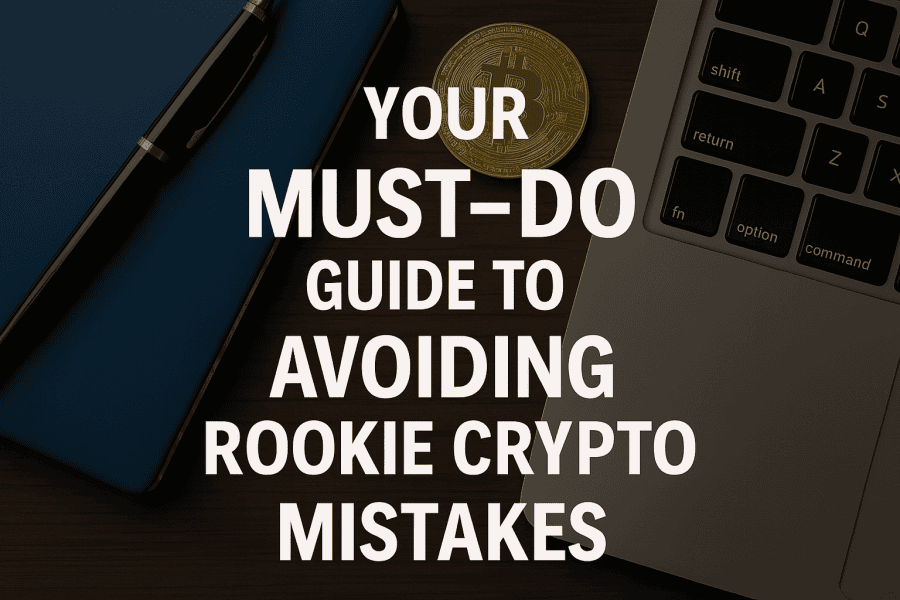
1. FOMO Trading: Letting Hype Override Strategy
When a coin suddenly surges and your social feed is ablaze with “To the moon!” predictions, it’s tempting to jump in. But trading on FOMO (Fear of Missing Out) is emotionally driven and rarely ends well.
🔹 Real Example: In 2021, many retail investors bought Dogecoin during its peak hype- only to watch it drop 70% in a matter of weeks.
🔹 What to do instead: Set predefined criteria for entering a trade – like market cap analysis, developer activity, or real-world utility – and never invest based on “everyone’s doing it.”

2. Going All-In: No, You’re Not the Next Crypto Millionaire (Yet)
Crypto can feel like a get-rich-quick dream. But putting your entire savings into one asset – especially a new or speculative coin is essentially gambling with your financial future.
🔹 Why it’s risky: Volatility in crypto isn’t a bug – it’s a feature. A 20% swing in a day is common.
🔹 Better approach: Diversify across a few high-conviction coins and stable assets. Limit your crypto exposure to a percentage you can mentally and financially handle.

3. Ignoring the Fundamentals: Investing Blindly in Buzzwords
You wouldn’t buy shares in a company without knowing what it does – so why do that with a cryptocurrency?
🔹 What to look for: Whitepapers, tokenomics, team background, roadmap. Understand what problem the coin solves and whether it has long-term adoption potential.
🔹 Tip: Use platforms like Messari or CoinGecko to research before investing.

4. No Exit Strategy: You Can’t “HODL” Forever
Many beginners have no plan for when to sell. They ride waves up – and then all the way down. This emotional rollercoaster often leads to regret.
🔹 What to do: Set take-profit and stop-loss levels before entering a trade. Stick to them. Consider a tiered exit (e.g., sell 25% at 30% profit, another 25% at 50%, etc.).
🔹 Golden rule: A trade not planned is a trade destined to fail.

5. Poor Security Habits: One Mistake Can Wipe Everything
Unlike traditional banks, crypto security is your responsibility. Beginners often leave funds on exchanges, use weak passwords, or fall for scams.
🔹 Real dangers: Phishing links, fake apps, exchange hacks.
🔹 What to do: Use a hardware wallet (like Ledger or Trezor), enable two-factor authentication, and store backup keys offline.

6. Trusting “Crypto Influencers” Blindly
In the era of crypto Twitter and viral TikToks, it’s easy to get swept up in charismatic personalities promoting obscure coins. But many influencers are paid to pump tokens – and disappear when the price crashes.
🔹 Check credibility: Look for transparency, track record, and whether they disclose partnerships.
🔹 Follow value, not volume: Some of the best traders rarely shout – they publish deep research instead of hype.

Ask Before You Trade: Common First-Timer Questions Answered
Q: Is crypto still a good investment in 2025?
A: Yes, but only with a clear strategy. Institutional adoption is growing, but so are regulatory complexities. Choose projects with long-term value.
Q: How much should I invest to start?
A: Start with an amount you’re prepared to lose. For most beginners, $100–$500 is a good sandbox to learn in. Focus on building your strategy, not your fortune – yet.
Q: Which platforms are safe to use?
A: Stick with regulated exchanges like Coinbase, Binance, or Kraken. Avoid platforms without a clear company structure or transparency.
Q: Should I trade or just invest long-term?
A: Trading is time-intensive and requires skill. If you’re new, consider dollar-cost averaging into strong coins (like Bitcoin and Ethereum) rather than chasing quick gains.
In Summary: Crypto Isn’t Magic – It’s a Skill
Success in crypto doesn’t come from luck or hype. It comes from patience, education, and discipline. Your first trade won’t define your journey – but learning from the common missteps of others can help you begin with confidence.
